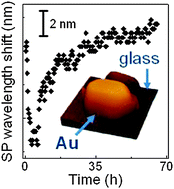Scientists from Israel and Japan have found a simple and effective route to the fabrication of stable Au island films, which are very useful in the field of localized surface plasmon resonance (LSPR) sensing. They additionally present a detailed kinetic study of the formation of gold nano-islands from gold films and their subsequent embedding into a glass substrate during annealing, in their recent PCCP paper.
The group used a combination of in-situ high temperature spectroscopy, high-resolution scanning electron microscopy, atomic force microscopy, cross-sectional transmission electron microscopy, and simulations using the Multiple Multipole Program approach to show that the morphological transformation of Au films proceeds via three processes exhibiting different time scales. They found that the embedding process is strongly temperature-dependent, but not dependant on the annealing atmosphere.
Discontinuous films of certain metals, such as gold, show a characteristic absorption band in the optical spectrum, attributed to excitation of localised surface plasmons, which can be influenced by the effective refractive index (RI) of the surrounding environment. This makes nanostructured metal films useful in chemical and biological sensing, as it is possible to quantify analyte binding to the metal surface by monitoring changes in the surface plasmon extinction band resulting from the local RI changes. A common problem in the preparation of reliable LSPR transducers for sensing, is poor adhesion between nanostructured Au films and substrates.
Read this HOT PCCP article today:
Mechanism of morphology transformation during annealing of nanostructured gold films on glass
Tanya Karakouz, Alexander B. Tesler, Takumi Sannomiya, Yishay Feldman, Alexander Vaskevich and Israel Rubinstein
DOI: 10.1039/C3CP50198A











